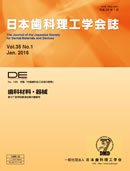MgHDT500 was synthesized by heating magnesium (Mg)-aluminum (Al) hydrotalcite (HDT), a highly adsorptive layered and microporous compound, at 500 ℃, and ZnHDT was synthesized by substituting Mg with zinc (Zn). Using obligate anaerobic bacterial cultures (Fusobacterium nucleatum ATCC25586 (F. nucleatum), Porphyromonas gingivalis ATCC33277, Prevotella intermedia ATCC25611, and Streptococcus mutans ATCC25175), the concentrations of H2S in mixtures with various HDTs were measured by gas chromatography to examine their inhibitory effects on H2S production and their antibacterial effects on the growth of F. nucleatum. Numerical data were statistically analyzed using one-way ANOVA and Fisher’s PLSD test (α=0.05). As a result, H2S was produced in all bacterial cultures, as determined using H2S concentrations for each test culture, with the highest H2S production with F. nucleatum. The H2S concentration changes in the F. nucleatum cultures mixed with various HDTs demonstrated that no H2S was detected at 2 hours for ZnHDT. The effects of various HDTs on the growth of F. nucleatum was examined, demonstrating a reduction in colony-forming units with ZnHDT. Thus, the significantly reduced concentrations of H2S produced by F. nucleatum were caused by the sulfide adsorption and antibacterial effects of ZnHDT.
View full abstract
